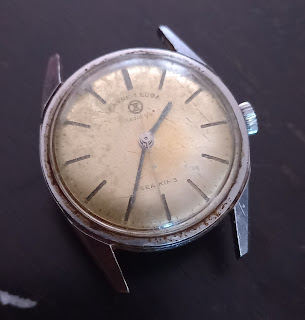010 - Citizen Automatic 61-0542
Up today is a Citizen Automatic from the 70s. It is a model 61-0542 and is from the time when Citizen was very much into producing watches with black anodised aluminium cases.
This particular example was received in poor condition, the movement as well as the hands and dial were in poor shape. The movement responded well to a service and the hands are from another model (I have some gold hands from another watch that will suit this watch better). Unfortunately I can't do much for the dial except give it a light clean. The main issue here is the surface of the dial is lifting away from the metal base around the edges. I can't glue it down as the material is really stiff and my guess is that it will break rather than bend. Perhaps heat may work but that may cause more problems. I guess I'll have to live it, its not really visible but it bothers me. You can see the edge of the dial next to the date window is a bit curved in the picture below.
The 6501 movement is a reliable workhorse, you can get some data in the Ranfft website here and there is a write-up on this movement here as well.
This is an aluminium case and this presents its own problems. The plus point of aluminium is that it is pretty light and it is very comfortable on the wrist, especially on this example where I have it on a light strap. The downside is that it is very soft. Citizen tried to solve it by anodizing it, this gives a hard wearing surface but it eventually wears down and once you've gone past the anodizing wear is accelerated. The aluminium case also presents problems with galvanic corrosion where two dissimilar metals encourage corrosion to the point where it can become very hard to open the caseback. I usually apply some heavy grease on the caseback threads to try to avoid this problem in the future.
The caseback, the first three digits of the serial number, 409 here, tells us that the watch was made in Sept. 1974. Citizen uses the second and third digits of the serial number to denote the month 01,02...10,11,23 compared to Seiko where they only use the second digit and use 0, N and D to denote October, November and December respectively. As a point of interest, the caseback is marked BLG which means this is a 'Black coated alloycase, Gold bezel'. My go to reference is Sweephand's excellent Citizen reference here. There is also a page dedicated to the case details here.
The watch also has a pretty hefty bezel as far as bezels go. The bezel extends to the edge which is quite normal but what is a bit unusual is that it does not surround the crystal but there is a portion of the case which serves as the boundary and transitions from the square bezel to a round crystal. I like it as it gives the watch some character. I'm not sure what the bezel material is but it looks like some base metal.
I have several of these Blackies which will eventually end up here. If you come across one and decide to buy it, one thing to check if the case has broken where the strap attaches. The aluminium is soft and I have a few where the case is scrap because the hole where the springbar goes has broken off.



















































 \
\







